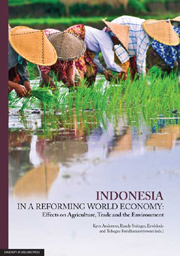Book contents
- Frontmatter
- Contents
- List of tables, figures and boxes
- FIGURES
- Acronyms
- Preface
- List of contributors
- 1 Introduction
- 2 Effects of growth, its interruption, and the Uruguay Round on Indonesian agriculture
- 3 Effects of AFTA and APEC trade policy reforms on Indonesian agriculture
- 4 Trade liberalisation and soil degradation in Indonesia
- 5 Will the Uruguay Round and APEC reforms harm air and water quality in Indonesia?
- 6 Impacts of agricultural protection growth at home and the WTO's Doha Round on Indonesian agriculture
- 7 Effects of agricultural policy reform on household and regional income distribution in Indonesia
- 8 Effects of farm policy reform on Indonesia's secondary food crops
- 9 Effects of agricultural policy reform in Indonesia on its food security and environment
- 10 Impacts of trade policy reform on income distribution and poverty in Indonesia
- APPENDIX 1 The WAYANG Model of the Indonesian economy
- APPENDIX 2 The GTAP Model and database
8 - Effects of farm policy reform on Indonesia's secondary food crops
Published online by Cambridge University Press: 05 June 2012
- Frontmatter
- Contents
- List of tables, figures and boxes
- FIGURES
- Acronyms
- Preface
- List of contributors
- 1 Introduction
- 2 Effects of growth, its interruption, and the Uruguay Round on Indonesian agriculture
- 3 Effects of AFTA and APEC trade policy reforms on Indonesian agriculture
- 4 Trade liberalisation and soil degradation in Indonesia
- 5 Will the Uruguay Round and APEC reforms harm air and water quality in Indonesia?
- 6 Impacts of agricultural protection growth at home and the WTO's Doha Round on Indonesian agriculture
- 7 Effects of agricultural policy reform on household and regional income distribution in Indonesia
- 8 Effects of farm policy reform on Indonesia's secondary food crops
- 9 Effects of agricultural policy reform in Indonesia on its food security and environment
- 10 Impacts of trade policy reform on income distribution and poverty in Indonesia
- APPENDIX 1 The WAYANG Model of the Indonesian economy
- APPENDIX 2 The GTAP Model and database
Summary
The economic crisis of the late 1990s led to an overhaul of Indonesia's agricultural policies. Influenced by the conditional loan requirements set by the International Monetary Fund (IMF) and other donor institutions, the government has liberalised trade policies. As pre-crisis policies imposed less interventions on secondary food than other crops, however, the impact of policy reform (especially trade policies) on these commodities is expected to be less.
This chapter has several objectives. It provides background data on secondary crops. It also contains details of institutional arrangements concerning these crops. Finally, it contains analysis of the assumed effects of altering R&D investments, so that they favour secondary food crops (i.e. maize, soybean and cassava) more than in the past, using the economy-wide WAYANG model (described in Appendix 1 of this volume).
Production and trade
Indonesia's agricultural land decreased around 1.1 million hectares during the period 1983-1993 (Kasryno, 1997). However, the harvested area of agricultural commodities has increased: an increase of cropping intensity has compensated for a decrease in land usage. During the period from 1969 to 1999, the harvested area of rice increased by 1.6 percent, maize 1.4 percent and soybean 3.5 percent annually, while cassava slightly decreased by 0.5 percent.
Up to mid-1997, the agricultural sector was very instrumental in supporting Indonesia's economic development. Growth in agricultural output, which was around 3 percent over 25 years, made it possible to provide relatively cheap food for the domestic population of more than 200 million people.
- Type
- Chapter
- Information
- Indonesia in a Reforming World EconomyEffects on Agriculture, Trade and the Environment, pp. 164 - 178Publisher: The University of Adelaide PressPrint publication year: 2009



